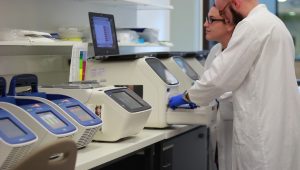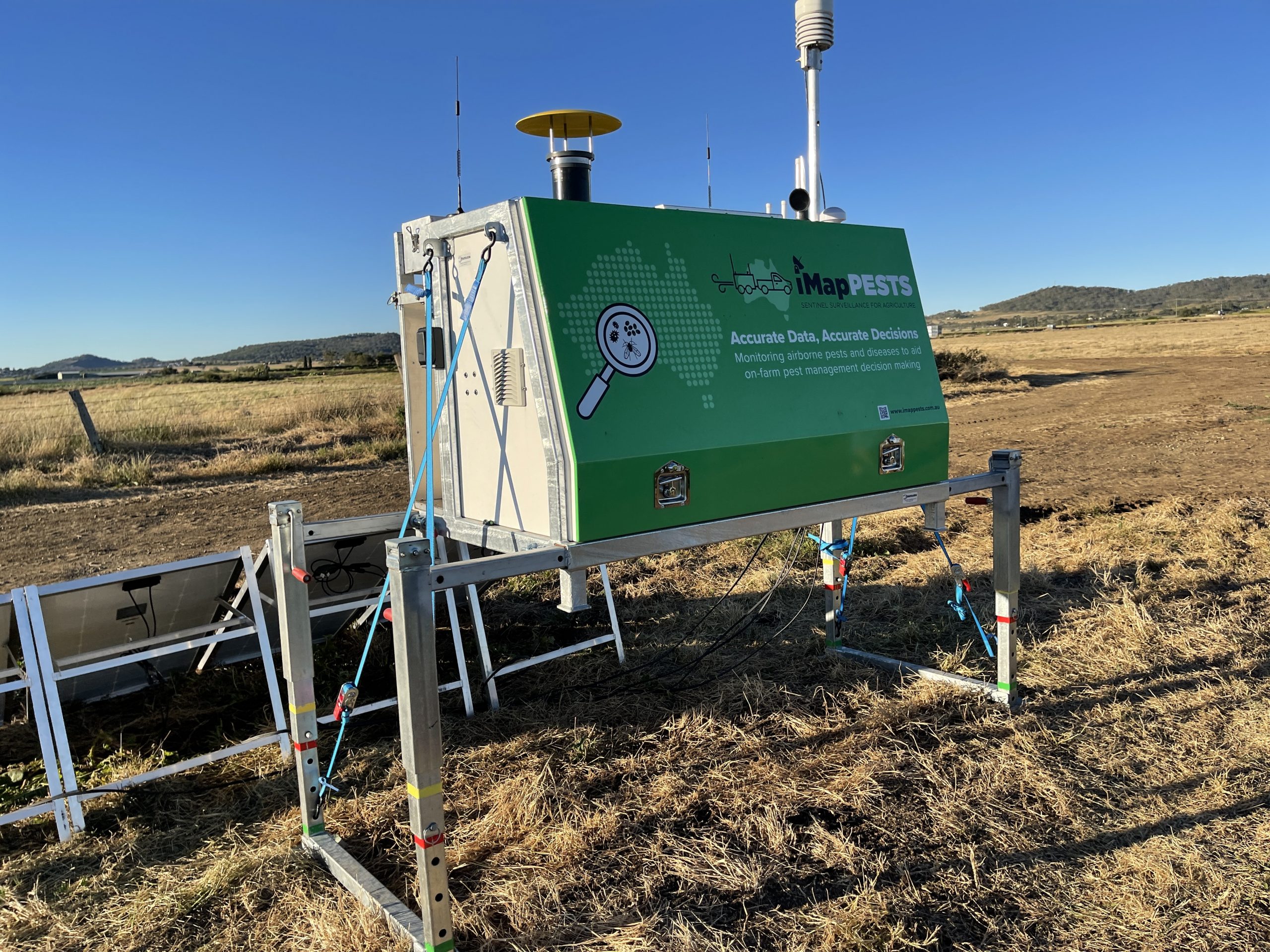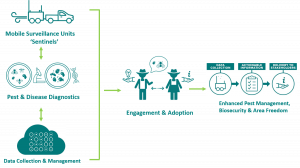
New humic acid product has the potential to kick start your soil health
4 October 2021
Disease profile: Potato Spindle Tuber Viroid
4 October 2021The ability to accurately monitor the timing, abundance and movement of airborne agricultural pests and pathogens is limited and fragmented across the Australian landscape. iMapPESTS is a five-year project that explores how cutting-edge surveillance, diagnostics and reporting tools can benefit industry. Shakira Johnson provides a project update.
The aim of the iMapPESTS: Sentinel Surveillance for Agriculture program is researching and developing smart surveillance and cutting-edge diagnostic technologies. These include custom-designed mobile surveillance units (termed ‘sentinels’) that incorporate specialised airborne trapping equipment and technology.
Sentinels are deployed to various locations around the country to capture airborne samples that are examined in a laboratory to test the presence or absence of priority pests and pathogens.
In a unique collaboration that is utilising the latest technologies, Australia’s agriculture and horticulture industries have joined forces to develop a national surveillance system capable of rapidly monitoring and reporting the presence of airborne pests and diseases for multiple agricultural sectors, including viticulture, grains, cotton, sugar, forestry and horticulture.
iMapPESTS completed the construction of six sentinels in early 2021, with a seventh expected to be rolled out later this year. Sentinels 5 and 6 were most recently unveiled in Queensland at Hort Connections and the Lockyer Valley Growers Expo back in June. Sentinel 6 has remained in Lockyer Valley where it is currently collecting samples over spring (see image at the top of the page).
Throughout the year, these six sentinels will be deployed to different growing regions around the country for extensive testing and optimisation.
Overview of the iMapPESTS: Sentinel Surveillance for Agriculture project.
Sentinel features
Every sentinel looks unique but all six share similar features – each is equipped with several airborne samplers, power supply, a weather station, telemetry and an industrial computer for remote control and monitoring. They also include automated technology to configure samplers for different sampling requirements.
The new edition units, Sentinels 4 through to 7, are smarter, smaller, lighter and more flexible compared with earlier sentinels, which is particularly important in a period where movement of people and goods can change quickly, and especially important for responsiveness to respond to biosecurity incursions.
As iMapPESTS nears the end of the initial sentinel development stage, the project team will deploy all seven sentinels to multiple strategic locations across the country for in-field trialling. This, includes key potato growing regions such as such as the Northern Adelaide Plains, Riverlands, Atherton and south-east Queensland and the Riverina. Each trial gives the team the opportunity to engage with stakeholders in the region and deliver important pest and disease data that could help inform on-farm pest management actions, biosecurity response efforts and area freedom claims.
Targets for reporting to industry
Laboratory analyses of the sentinel samples quantifies the pests and pathogens present. Molecular testing can deal with large numbers of samples rapidly and accurately. Yet, molecular tests for many of the pests and pathogens do not yet currently exist. iMapPESTS includes the development of is developing more diagnostic tests using next-generation sequencing by Agriculture Victoria (AgVic), Sugar Research Australia and University of Queensland.
A priority pest and disease list has been developed to monitor targets across each of the diverse plant industries, with a focus on targets that affect multiple industries (e.g. green peach aphid and grey mould caused by Botrytis). After the sentinel captures airborne pests and diseases – including many long-distance dispersal insects such as aphids – the samples are dispatched to SARDI and/or AgVic for inspection.
Rohan Kimber, research scientist at the South Australian Research and Development Institute (SARDI), uses Western flower thrips as an example of a destructive pest.
The localised reporting of pests and pathogens aims to provide farmers across industry sectors with improved ability to make decisions relating to pest management on-farm.
“Western flower thrips spread across the Australian landscape. They can survive and build up in crops that have low susceptibility, and then fly to potato and vegetable crops where they transmit viruses, such as tomato spotted wilt virus,” Dr Kimber said.
Visualising patterns of individual pest and pathogen occurrences, together with weather data, will help researchers and decision makers build an understanding of pest and population dynamics.
“These trials are not only providing us with valuable insights into pest and pathogen populations and dynamics, but are helping us identify the most effective and efficient insect and spore samplers for target capture,” Dr Kimber said.

Elisse Nogarotto and Dr Francesco Martoni pictured performing high throughput diagnostics trials using Next Generation Sequencing at AgriBio, Melbourne.
Next generation diagnostics for biosecurity targets also delivers snapshot of insect biodiversity
Molecular testing can deal with large numbers of samples rapidly and accurately. Yet, molecular tests for many of the pests and pathogens do not yet exist. iMapPESTS includes the development of more diagnostic tests using next-generation sequencing by AgVic, Sugar Research Australia and University of Queensland.
The iMapPESTS diagnostics collaboration is exploring something known as high throughput sequencing (HTS) to investigate ways of reporting on a wider range of insects captured, including targets of biosecurity concern.
This is because the HTS approach takes a sample of insects or fungi captured by the trap and sucks out all the genetic code, resulting in a ‘DNA soup’ that can be scanned using a reference tool, or database, of known DNA codes for hundreds of thousands of different insects or fungal species.
If a particular species was trapped, its DNA code will be present in the soup and flagged by the reference database, indicating its presence in the trap. These techniques have the potential to detect many targets in one test and pick-up biosecurity threats early, allowing for a more effective response to an incursion.
To further investigate the impact of this new diagnostics method and how it might work in the iMapPESTS surveillance system, a selection of insect samples from the sentinels are being processed at AgVic’s AgriBio using the HTS diagnostic method. The results will be made available on the iMapPESTS website.
iMapPESTS website: Central information hub for industry
The iMapPESTS website includes an interactive map of locations for current and previous sentinel trials. People can interrogate that will take you to individual trial pages where stakeholders can interrogate the data collected for insects and pathogens trapped at a particular trial site.
During sentinel trials, data is regularly shared through these pages as summaries and observations from iMapPESTS entomologists, plant pathologists and local service providers (including crop consultants and agronomists), as well as a data dashboard that features weather (temperature, rainfall, and humidity), and pest and pathogen numbers.
By the end of the project in 2022, the team aims to have a demonstrated a proof-of-concept surveillance system that is suitable to different regions and supported by the appropriate rapid diagnostic tests for key insect pests and pathogens across industry sectors.
The iMapPESTS team will work with growers and industry representatives to understand the best way to communicate and visualise the dynamic pest and pathogen information for end-users. Growers and those involved in plant pest management are encouraged to visit the iMapPESTS website for more information or to get in touch.
Find out more
Please contact Engagement and Adoption Coordinator for iMapPESTS Shakira Johnson on 0433 937 564 or shakira.johnson@ausveg.com.au.
Further details can be found on the iMapPESTS website. You can follow the project on Twitter.
The program (2017-2023) is supported by Horticulture Innovation Australia Limited, through funding from the Australia Government Department of Agriculture, Water and the Environment as part of its Rural R&D for Profit Program and Grains Research & Development Corporation, Sugar Research Australia, Cotton Research & Development Corporation, Wine Australia, AgriFutures Australia, and Forest and Wood Products Australia.
Project Number: ST16010
Cover image: Sentinel 6 at Campsey Ash Farms in the Lockyer Valley, Queensland.


